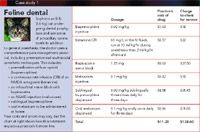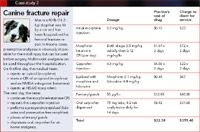The economics of pain relief
You know that a comprehensive analgesic protocol is necessary for your patients. But these drugs have a noticeable side effect-a financially healthy practice.
By now there's no question that pain management is good medicine. For one thing, it's just plain miserable to see an animal suffering—let alone to be the animal that's suffering. What's more, untreated pain can lead to a prolonged hospital stay, mental distress, gastrointestinal lesions, disseminated intravascular coagulation, immunosuppression, arrhythmias, and decreased wound healing.

Feline dental
As is so often the case, good medicine is also good business. When you implement a comprehensive pain management protocol and charge appropriately for it, it can make a significant positive impact on your practice's bottom line. Here we'll discuss two pillars of a comprehensive pain management program: preemptive and multimodal analgesia.
Preemptive analgesia refers to blocking the pain pathway before the painful stimulus occurs—in other words, getting pain-relieving drugs on board before surgery or another painful procedure. This decreases the intensity and duration of postoperative pain and also reduces the amount of induction and maintenance anesthesia necessary.
Multimodal analgesia refers to the use of analgesic drugs from several classes to achieve a synergistic effect. By doing this, you increase your chances of successfully preventing and treating pain in your patients. These different drug classes include opioids, nonsteroidal anti-inflammatory drugs (NSAIDs), local anesthetics, alpha-2 agonists, and N-methyl-D-aspartate (NMDA) antagonists.
The case studies on this page and the next demonstrate how you can employ comprehensive pain management in two common procedures in cats and dogs and how you can charge for these medications profitably.
In these examples, the epidural should be performed by a veterinarian, but all the other procedures can be performed by a trained technician. (Licensing and drug-administration regulations vary by state but, in general, technicians and assistants can administer controlled substances under the supervision of a veterinarian.)

Canine fracture repair
These examples don't include the minimal costs of syringes and other supplies, but it's still evident that providing analgesia for our patients and charging appropriately for it generates income for the practice. Implicit in the markup of the drugs' cost is the reality that you are providing a service: The medical team is administering these drugs safely and effectively—so you can continue to emphasize a service-driven, not product-driven, approach.
Setting up a pain management protocol
The first step: You must write it down. All doctors in the practice should give their input, and your final written protocol should address your team's use of analgesic drugs, including doses, mechanisms of action, indications, and contraindications; preemptive analgesic techniques; and methods for recognizing pain.
Once you establish the written protocol, your team must decide how to charge clients for pain management services. Some practices charge separately for each drug or technique, while others charge a single "comprehensive pain management" fee to include any drugs or techniques used. My practice charges separately for each service, although certain techniques are included with elective surgeries, like a carpal ring block for a feline declaw. Dr. Angela Dyer, an associate at Noah's Ark Veterinary Clinic in Goleta, Calif., favors a single comprehensive pain management charge for all in-hospital analgesia; dispensed medications are charged separately. "Using a single comprehensive charge allows us to use what the patient needs without feeling like we're charging a lot extra to the client. It removes the possibility of withholding needed medications based on perception of clients' willingness to pay," Dr. Dyer says.

The path to pain relief
Other practices may use a single comprehensive charge for elective procedures but charge each drug or technique separately for nonelective procedures. Dr. David Thompson, owner of Clyde Park Veterinary Clinic in Wyoming, Mich., charges each item separately. "It would be impossible to have a flat fee because the techniques we use vary so much from patient to patient," he says.
Getting the team involved
The next step is to get staff members on board. Hold a meeting to explain different techniques—for example, ring blocks, dental blocks, epidurals, and CRIs—and their benefits to patients. Once technicians and receptionists see how comfortable patients are with analgesia, they'll be able to explain the benefits to clients.
In fact, at my practice, technicians are very attuned to the animals' comfort and often request that the veterinarian administer additional analgesics to painful patients. And when clients visit their hospitalized patients, the technicians explain exactly what's been done to alleviate pain.
If you're reluctant to use aggressive analgesic protocols because you worry clients will resist increased charges, consider this: My practice has had very few clients complain about the fees. Dr. Richard Headley, owner of Lincolnway Veterinary Clinic in Mishawaka, Ind., agrees. "My clients have unanimously approved of analgesic treatment, to the point of expecting it," he says.
If you can't convince a client of the benefits of pain management, then encourage him or her to seek care elsewhere. "Anesthesia is not optional," Dr. Headley says. "Neither is analgesia. I had one client complain about her 4-year-old cat getting a fentanyl patch for a declaw surgery. I fired her on the spot."
When price shoppers call and ask about certain procedures, I suggest that you include pain management in the quote and make it mandatory. If it's presented as an option, some clients will decline. This puts you in the awkward position of either cheating the patient by withholding analgesia or cheating the practice by administering analgesia without charging for it.
If you're just now starting a pain management protocol, you can add charges gradually as you, your team, and your clients become more comfortable with the procedures. For example, if you have not previously used or charged for pain injections, you might start with a minimal charge of $8. This will generally cover the cost of the medication, and then you can increase the fee over a period of several months. Implementing a pain management protocol takes time and energy, but the benefits to the patient and the practice definitely make it worthwhile.
Dr. Laura McLain Madsen practices at Central Valley Veterinary Hospital in Salt Lake City. Send questions or comments to ve@advanstar.com